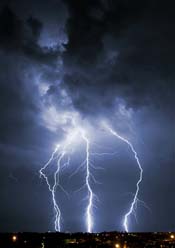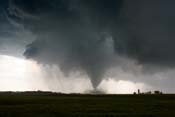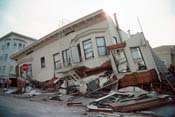Thunderstorms: Seek shelter in a building and be sure to close all windows, pulling the shades in case of shattering glass. When the storm appears to be finished, it is best to remain indoors until at least 30 minutes after you hear the last thunderclap. If you can hear a stormās rumbling, you are close enough to be struck by lightning.
If it is not possible to go inside, keep low to the ground and avoid bodies of water, large open spaces, isolated objects, and tall metal structures. Crouch down on the balls of your feet with your legs together and keep your hands off the ground. Turn off any electrical devices as these could conduct electricity.
Tornadoes: Often, tornado watches or warnings are issued in advance, which provide time to take shelter. A tornado watch is issued if conditions are favorable for producing a twister. A tornado warning, however, is given when one has actually been sighted. If this happens, seek shelter immediately. The sky can also itself be a warningāif it turns a sickly green color or if clouds begin to swirl into a funnel cloud, a tornado may be on its way.
In the event of a tornado, seek shelter in a basement in a small, interior room. Get down on your knees by a sturdy piece of furniture and cover your head with your arms. During a tornado, the greatest danger is the possibility of being hit by flying debris, so, if you are in a safe place indoors, position yourself away from windows, shelves, light fixtures and other potentially dangerous objects. Avoid upstairs rooms as tornadoes often shatter windows and sometimes rip the tops off houses.
If caught outside, it is safest to lie in an area of low elevation, such as a ditch, rather than trying to outrun a tornado.
Earthquakes: If indoors when an earthquake strikes, stay near the buildingās exterior. Position yourself near a structural strong point of the room, such as a doorframe, and in an area where you will not be hit by falling objects. If you are not near a doorway, get down on your knees next to a piece of sturdy furniture and hold onto its base. Should the building collapse, āsafe voidsā of space are often created next to these objects, which can prevent you from getting seriously injured.
Once the ground stops shaking, avoid striking a match to light your way through the dark if the power has gone out, as earthquakes sometimes break gas lines, which can cause explosions.
If outside, move to an open area and stay away from objects that could fall and injure you, such as power lines or trees.
Note: Though you may never experience severe weather and earthquakes, they can happen unexpectedly. Discuss plans for how to react to each with your parents. It may be wise to designate a āsafe areaā where you can meet and have a kit prepared with essentials, such as first aid supplies, a battery-operated radio, a flashlight and drinking water.

Source: canstockphoto.com

Source: canstockphoto.com

Source: Getty Images



















